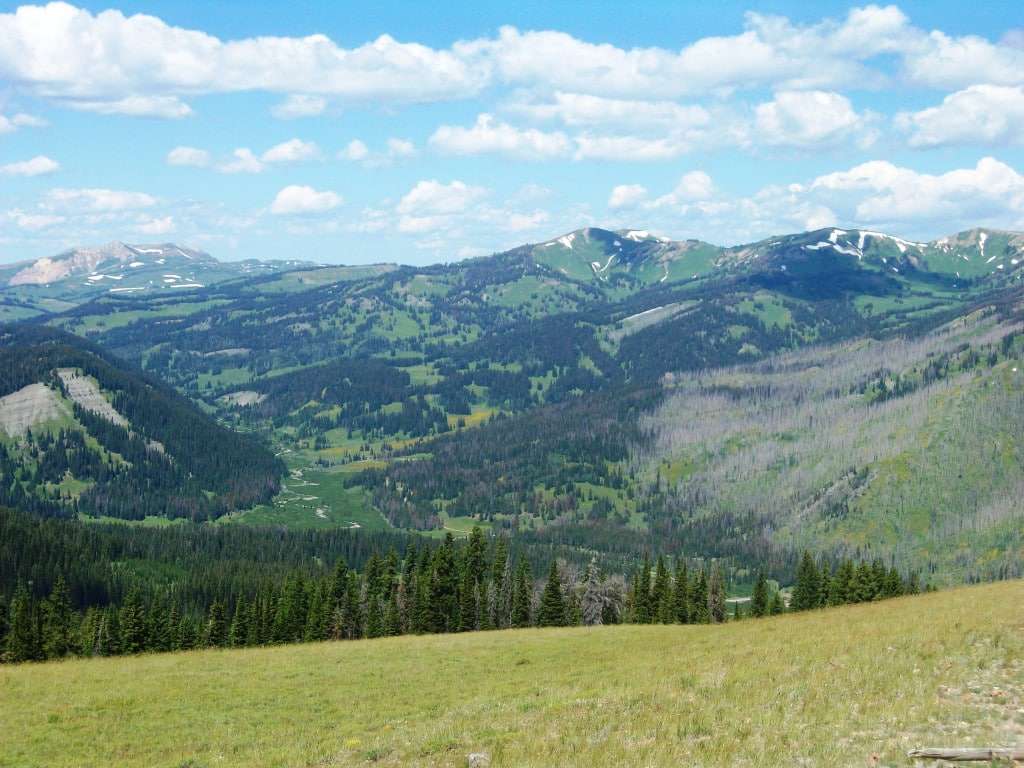
| The Wyoming Range is located in west-central Wyoming — part of the Rocky Mountains — and stretches north-south near the western edge of the state. The highest peak in the Wyoming Range is Wyoming Peak, at 11,363 feet. |
Jan. 26, 2017
Dear Sportsmen and Sportswomen,
Since December 2005, sportsmen and sportswomen like you have worked diligently to prevent oil and gas development on 40,000 prime acres in the Wyoming Range of the Bridger-Teton National Forest. We are happy to report that this effort is reaping what it has sown.
On January 17th the U.S. Department of Agriculture Undersecretary for Natural Resources and Environment, Robert Bonnie, signed a “no leasing” Record of Decision formally withdrawing the controversial oil and gas leases in question, protecting the critical wildlife habitat, native trout fisheries and popular backcountry recreational sites within the boundaries. Barring a federal lawsuit or successful appeal, the door is now permanently closed to oil and gas leasing and development in the entire Wyoming Range. A trio of efforts made this possible: last week’s signed decision, the 2012 negotiated sale and retirement of existing leases on 60,000 acres in the Hoback Basin, and the 2009 Wyoming Range Legacy Act, which permanently removed leasing from the table for 1.2 million acres within the Wyoming Range of the Bridger-Teton National Forest.
This beloved country is abundant encompassing Thompson Pass, Horse Creek, McDougal Gap, North and South Cottonwood Creeks, Lander Peak, and Piney Creek. Wildlife in the Wyoming Range include genetically pure Colorado River cutthroat trout, Snake River cutthroat trout, black and grizzly bears, elk, half of the state’s moose population, and the northern end of the longest mule deer migration corridor in the world.
A big thank you goes out to Bridger-Teton National Forest Supervisor Patricia O’Connor and her staff for their science-based decision. The ‘no leasing’ decision is a result of the Forest Service carefully reviewing scientific documentation, studies, expert opinions, public comments and taking into account ‘sense of place.’
Throughout this decade long campaign local sportsmen and sportswomen like you have provided a critical voice, offering testimonials on the importance and values of the area to their quality of life. Thank you for your passion to conserve landscapes too valuable for development.
Because of your efforts quality hunting, fishing, camping, and outdoor family values will continue in the Wyoming Range, and be shared with our families and friends in perpetuity.
It has been our pleasure working with you and Wyoming’s wildlife thank you. Congratulations!
Sincerely,
Sportsmen for the Wyoming Range
_____________________________________________________________________________
WWF PAST Reports
Final public comments were provided in June on the Bridger-Teton National Forest’s draft environmental impact study of 39,490 acres in the Wyoming Range considered for oil and gas exploration and development. WWF with the Sportsmen for the Wyoming Range have invested time, relationships and finances ensuring this special place stays just like it is, perfect.
Several conservation and special interest groups submitted comments, including WWF, Trout Unlimited and National Outdoor Leadership School. Many supportive comments were generated through communications with our membership and with students who use the Wyoming Range and consider this pristine area their backyard outdoor recreational playground.
WWF and Sportsmen for the Wyoming Range would like to send a HUGE thank you to those who took the time to comment in support of Alternative 1—no leasing.
Donald Kranendonk, Big Piney District Ranger, reported that they had received upwards of 20,000 email comments and approximately 100-200 letters/postcards primarily from conservation organizations and conservation minded special interest groups. He also mentioned they had received some private emails from oil and gas interests.
Once again, the conservation and sportsmen and sportswomen communities came together to voice their opinion on the controversial nature of offering up the Wyoming Range for oil and gas leasing.
The exploratory proposal is from True Oil, of Casper, with the aim to drill two wells on two well pads about 50 miles south of Jackson. When the Bridger-Teton National Forest publicized the proposal last fall, WWF and other groups, as well as state agencies and residents provided comments.
- U.S. Forest Service has identified the South Cottonwood Creek drainageas, where the oil and gas wells are proposed, as a valuable coldwater refuge for aquatic species.
- WWF, Trout Unlimited and other groups are calling for a full environmental assessment for this energy development proposal.
- In addition to aquatic species, the Wyoming Game and Fish Department has asked the Forest Service to consider the effects on the Wyoming Range Mule Deer Herd and the Piney Elk Herd. Stress associated with human activity in this area where mule deer are known to fawn could further impact this deer population, says Game and Fish. Elk could also be impacted by development disturbance, especially during the elk calving season.
- Portions of the West Fork and South Fork of Bare Creek, Lander Creek, Trailer Creek and South Cottonwood Creek are currently on a leasehold surrounded by U.S. Forest Service land protected by the 2009 Wyoming Range Legacy Act that withdrew 1.2 million acres of Forest Service lands from future oil and gas leasing and development.

